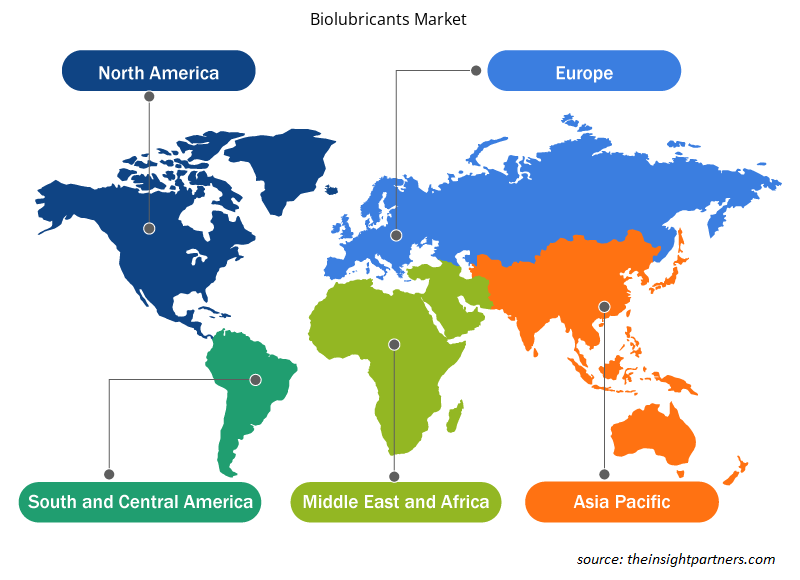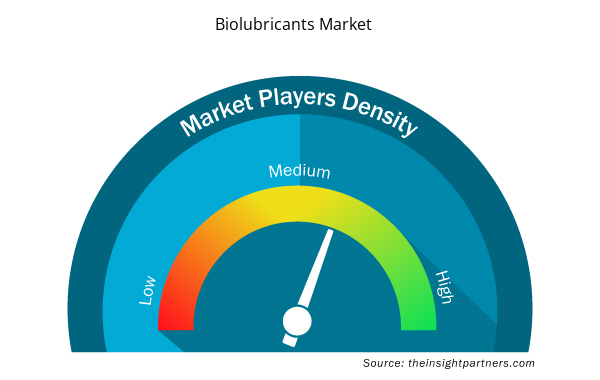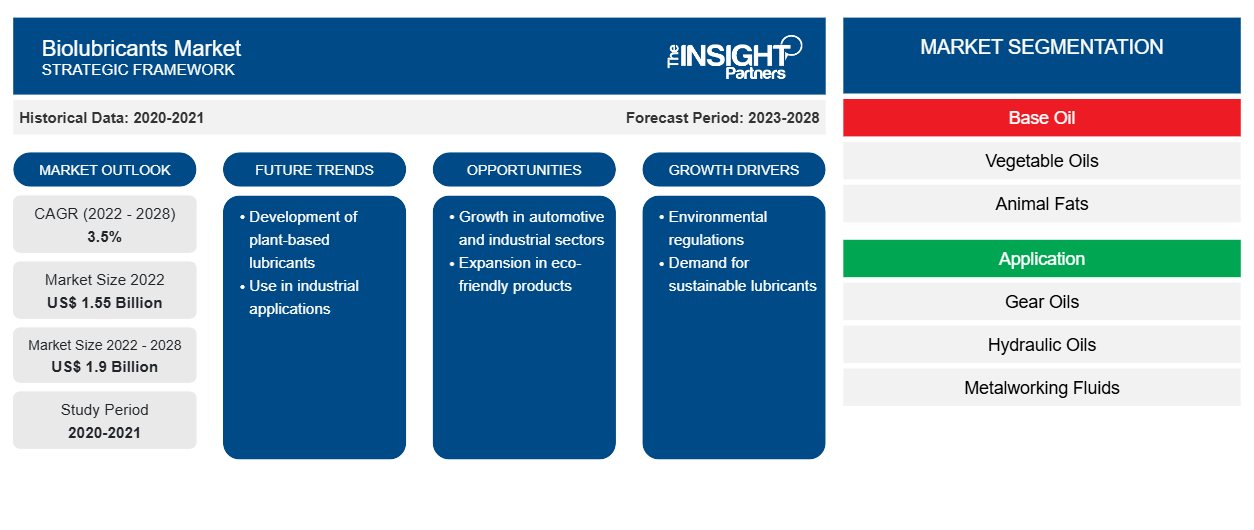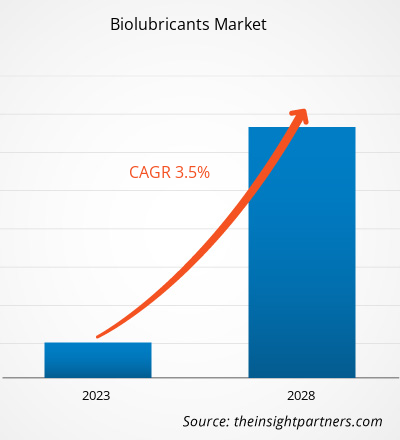Der Markt für Bioschmierstoffe soll von 1.551,15 Millionen US-Dollar im Jahr 2022 auf 1.902,41 Millionen US-Dollar im Jahr 2028 wachsen; für den Zeitraum von 2022 bis 2028 wird eine durchschnittliche jährliche Wachstumsrate (CAGR) von 3,5 % erwartet.
Bioschmierstoffe werden aus Ölen hergestellt, die aus Pflanzen und anderen erneuerbaren Ressourcen, einschließlich tierischer Produkte, gewonnen werden. Bioschmierstoffe sind biologisch abbaubar und für Menschen und Gewässer ungiftig. Die biologische Abbaubarkeit von Bioschmierstoffen spielt eine entscheidende Rolle bei Anwendungen, bei denen ein hohes Risiko des Austretens in die Umwelt besteht. Darüber hinaus haben Bioschmierstoffe höhere Flammpunkte, eine konstante Viskosität und weniger Ölnebel-/Dampfemissionen und bieten so mehr Sicherheit. Bioschmierstoffe erzeugen auch weniger Emissionen und haften besser an Metalloberflächen. Sie werden in verschiedenen Anwendungen eingesetzt, darunter Motoren, Getriebe, Hydraulik, Kettensägen, Schmierfette und 2-Takt-Schnellbootmotoren. Bioschmierstoffe werden in verschiedenen Endverbrauchsbranchen wie Automobil, Schifffahrt, Land- und Forstwirtschaft, Bergbau, Bauwesen, Kraftübertragung, Lebensmittel und Pharmazeutik häufig verwendet.
Das Wachstum des Marktes für Bioschmierstoffe ist auf die steigende Nachfrage nach Bioschmierstoffen aus verschiedenen Endverbrauchsbranchen zurückzuführen, die auf ein gestiegenes Umweltbewusstsein, strenge Umweltgesetze, die die Verwendung umweltverträglicher Schmierstoffe vorschreiben, und die hohen Entsorgungskosten der bestehenden nicht abbaubaren Schmierstoffe zurückzuführen ist. In vielen Ländern gibt es Vorschriften, die die Verwendung von Schmierstoffen auf Mineralölbasis auf Binnenwasserstraßen verbieten. Solche Vorschriften treiben die Nachfrage nach Bioschmierstoffen für verschiedene Anwendungen voran. Da Bioschmierstoffe sauber und ungiftig sind, ist ihre Verwendung in hochsensiblen Anwendungen wie der Forstwirtschaft und der Schifffahrt in einigen Ländern der Welt vorgeschrieben. In der Schifffahrt werden Bioschmierstoffe in verschiedenen Abschnitten und Prozessen von Containern, Frachtflotten, Öltankern und anderen Schiffen zu Schmierzwecken verwendet. Zu den Bioschmierstoffen für die Schifffahrt gehören Motoröle, Hydrauliköle, Kompressoröle, Gleitbahnöle, Getriebeöle, Wärmeübertragungsöle, Fette, Turbinenöle und andere. Darüber hinaus hat das Wachstum des weltweiten internationalen Seehandels die Nachfrage nach Bioschmierstoffen angekurbelt, da sie eine hohe Effizienz und geringe Emissionskapazität aufweisen. Daher wird der verstärkte Einsatz von Bioschmierstoffen in der Schifffahrtsindustrie im Prognosezeitraum lukrative Möglichkeiten für den Bioschmierstoffmarkt bieten.
Passen Sie diesen Bericht Ihren Anforderungen an
Sie erhalten kostenlos individuelle Anpassungen an jedem Bericht, einschließlich Teilen dieses Berichts oder einer Analyse auf Länderebene, eines Excel-Datenpakets sowie tolle Angebote und Rabatte für Start-ups und Universitäten.
- Holen Sie sich die wichtigsten Markttrends aus diesem Bericht.Dieses KOSTENLOSE Beispiel umfasst eine Datenanalyse von Markttrends bis hin zu Schätzungen und Prognosen.
Markteinblicke
Steigende Nachfrage aus der Automobilindustrie treibt Wachstum auf dem Markt für Bioschmierstoffe voran
Motoröle, Getriebeöle, Brems- und Hydraulikflüssigkeiten sowie andere Fahrzeugöle werden in der Automobil- und Transportindustrie verwendet. Bioschmierstoffe werden als reibungs- und wärmeabsorbierende Medien verwendet und sorgen für reibungslose und zuverlässige Funktionen/Abläufe. Sie verringern das Risiko häufiger Ausfälle und tragen zur Verlängerung der Lebensdauer des Fahrzeugs bei. Fahrzeugschmierstoffe werden verwendet, um die Reibung zu verringern und die Wärme zu regulieren, die entsteht, wenn zwei Oberflächen miteinander in Kontakt kommen. Darüber hinaus weisen Motoröle auf Biobasis eine höhere inhärente biologische Abbaurate, eine geringe Toxizität für Wasserorganismen und eine sehr geringe Bioakkumulation auf. Darüber hinaus ist der Ersatz von Ölen auf Kohlenwasserstoffbasis durch biologisch abbaubare Produkte eine Möglichkeit, die negativen Auswirkungen von Schmierstoffen auf das Ökosystem zu verringern. Mit dem zunehmenden regulatorischen Druck zur Verbesserung der Kraftstoffeffizienz von Fahrzeugen und zur Reduzierung der Treibhausgasemissionen hat es eine bemerkenswerte Entwicklung bei Ölschmierstoffformulierungen gegeben. Diese Faktoren steigern die Nachfrage nach Bioschmierstoffen in der Automobilindustrie.
Einblicke in Grundöle
Basierend auf dem Grundöl ist der Markt für Bioschmierstoffe in Pflanzenöle, tierische Fette und andere unterteilt. Das Segment Pflanzenöle hatte im Jahr 2022 den größten Marktanteil. Pflanzenöle sind aufgrund bestimmter inhärenter Eigenschaften, darunter hohe Viskosität, hoher Siedebereich und biologische Abbaubarkeit, bevorzugte Alternativen zu Mineralölen als Schmierstoffgrundstoffe. Fettsäuren im Öl können chemisch modifiziert werden, um hochmolekulare Ester zu bilden, die herkömmliche Schmierstoffe auf Mineralölbasis ersetzen können. Diese Faktoren werden voraussichtlich das Wachstum des Marktes für das Segment Pflanzenöle vorantreiben.
Emery Oleochemicals LLC, Fuchs Petrolub SE, Carl Bechem GmbH, PANOLIN AG, Renewable Lubricants Inc, TotalEnergies SE, Shell Plc, RSC Bio Solutions LLC, Crevier Group Inc und Kluber Lubrication GmbH & Co KG gehören zu den wichtigsten Akteuren auf dem Markt für Bioschmierstoffe. Die führenden Akteure verfolgen Strategien wie Fusionen und Übernahmen sowie Produkteinführungen, um ihre geografische Präsenz und Kundenbasis zu erweitern.
Regionale Einblicke in den Markt für Bioschmierstoffe
Die regionalen Trends und Faktoren, die den Markt für Bioschmierstoffe im Prognosezeitraum beeinflussen, wurden von den Analysten von Insight Partners ausführlich erläutert. In diesem Abschnitt werden auch die Marktsegmente und die Geografie von Bioschmierstoffen in Nordamerika, Europa, im asiatisch-pazifischen Raum, im Nahen Osten und Afrika sowie in Süd- und Mittelamerika erörtert.

- Erhalten Sie regionale Daten zum Bioschmierstoffmarkt
Umfang des Marktberichts zu Bioschmierstoffen
| Berichtsattribut | Details |
|---|---|
| Marktgröße im Jahr 2022 | 1,55 Milliarden US-Dollar |
| Marktgröße bis 2028 | 1,9 Milliarden US-Dollar |
| Globale CAGR (2022 - 2028) | 3,5 % |
| Historische Daten | 2020-2021 |
| Prognosezeitraum | 2023–2028 |
| Abgedeckte Segmente | Nach Grundöl
|
| Abgedeckte Regionen und Länder | Nordamerika
|
| Marktführer und wichtige Unternehmensprofile |
|
Marktdichte von Bioschmierstoffen: Auswirkungen auf die Geschäftsdynamik verstehen
Der Markt für Bioschmierstoffe wächst rasant, angetrieben durch die steigende Nachfrage der Endverbraucher aufgrund von Faktoren wie sich entwickelnden Verbraucherpräferenzen, technologischen Fortschritten und einem größeren Bewusstsein für die Vorteile des Produkts. Mit steigender Nachfrage erweitern Unternehmen ihr Angebot, entwickeln Innovationen, um die Bedürfnisse der Verbraucher zu erfüllen, und nutzen neue Trends, was das Marktwachstum weiter ankurbelt.
Die Marktteilnehmerdichte bezieht sich auf die Verteilung der Firmen oder Unternehmen, die in einem bestimmten Markt oder einer bestimmten Branche tätig sind. Sie gibt an, wie viele Wettbewerber (Marktteilnehmer) in einem bestimmten Marktraum im Verhältnis zu seiner Größe oder seinem gesamten Marktwert präsent sind.
Die wichtigsten auf dem Markt für Bioschmierstoffe tätigen Unternehmen sind:
- Emery Oleochemicals LLC
- Fuchs Petrolub SE
- Carl Bechem GmbH
- PANOLIN AG
- Erneuerbare Schmierstoffe Inc.
Haftungsausschluss : Die oben aufgeführten Unternehmen sind nicht in einer bestimmten Reihenfolge aufgeführt.

- Überblick über die wichtigsten Akteure auf dem Markt für Bioschmierstoffe
Bericht-Spotlights
- Fortschrittliche Trends in der Bioschmierstoffindustrie helfen den Akteuren bei der Entwicklung wirksamer langfristiger Strategien
- Von Unternehmen verfolgte Geschäftswachstumsstrategien zur Sicherung des Wachstums in entwickelten und sich entwickelnden Märkten
- Quantitative Analyse des globalen Bioschmierstoffmarktes von 2020 bis 2028
- Abschätzung des Bedarfs an Bioschmierstoffen in verschiedenen Branchen
- Porters Fünf-Kräfte-Analyse zur Veranschaulichung der Wirksamkeit von Käufern und Lieferanten in der Bioschmierstoffindustrie
- Aktuelle Entwicklungen zum Verständnis des Wettbewerbsmarktszenarios und der Nachfrage nach Bioschmierstoffen
- Markttrends und -aussichten sowie Faktoren, die das Wachstum des Bioschmierstoffmarktes bestimmen
- Aufschlussreiche Strategien, die das kommerzielle Interesse am Marktwachstum untermauern und den Entscheidungsprozess unterstützen
- Marktgröße für Bioschmierstoffe an verschiedenen Marktknoten
- Detaillierte Übersicht und Segmentierung des Marktes sowie seiner Branchendynamik
- Marktgröße für Bioschmierstoffe in verschiedenen Regionen mit vielversprechenden Wachstumschancen
Die „Bioschmierstoff-Marktprognose bis 2028“ ist eine spezialisierte und eingehende Studie der Chemie- und Materialindustrie, die sich auf die Trendanalyse des Bioschmierstoff-Marktes konzentriert. Der Bericht soll einen Überblick über den Markt mit detaillierter Segmentierung geben. Der Bioschmierstoff-Markt ist auf der Grundlage von Grundöl, Anwendung, Endverbrauch und Geografie segmentiert. Basierend auf dem Grundöl ist der Markt in Pflanzenöle, tierische Fette und andere segmentiert. Basierend auf der Anwendung ist der Markt in Getriebeöle , Hydrauliköle, Metallbearbeitungsflüssigkeiten, Fette und andere segmentiert. Nach Endverbrauch ist der Bioschmierstoff-Markt in Automobil, Industrie, Schifffahrt, Land- und Forstwirtschaft und andere segmentiert. Der Markt ist in fünf Hauptregionen segmentiert: Nordamerika, Europa, Asien-Pazifik, Naher Osten und Afrika sowie Süd- und Mittelamerika. Im Jahr 2022 dominierte Europa den Bioschmierstoff-Markt. Der Asien-Pazifik-Raum wird im Prognosezeitraum voraussichtlich die höchste CAGR auf dem Markt verzeichnen. Faktoren wie wachsende Umweltbedenken und steigende Rohölkosten treiben die Nachfrage nach Bioschmierstoffen in Europa an. Die Nachfrage nach Bioschmierstoffen im asiatisch-pazifischen Raum ist direkt proportional zur Industrialisierung und Fahrzeugproduktion in der Region. Wachsende regionale Bautätigkeiten sowie der Industrie- und Automobilsektor beschleunigen das Marktwachstum.
- Historische Analyse (2 Jahre), Basisjahr, Prognose (7 Jahre) mit CAGR
- PEST- und SWOT-Analyse
- Marktgröße Wert/Volumen – Global, Regional, Land
- Branche und Wettbewerbsumfeld
- Excel-Datensatz


- Non-Emergency Medical Transportation Market
- Bathroom Vanities Market
- Extracellular Matrix Market
- Data Center Cooling Market
- Employment Screening Services Market
- Neurovascular Devices Market
- GNSS Chip Market
- Excimer & Femtosecond Ophthalmic Lasers Market
- Hand Sanitizer Market
- Medical and Research Grade Collagen Market

Report Coverage
Revenue forecast, Company Analysis, Industry landscape, Growth factors, and Trends

Segment Covered
This text is related
to segments covered.

Regional Scope
North America, Europe, Asia Pacific, Middle East & Africa, South & Central America

Country Scope
This text is related
to country scope.
Häufig gestellte Fragen
The major driver for the growth of the biolubricants market is the growing demand for biolubricants from various end-use industries due to increased environmental consciousness, strict environmental laws mandating the use of environmentally acceptable lubricants, and the high disposal expense of the existing non-degradable lubricants. In many countries, there are regulations that forbid the use of mineral oil-based lubricants around inland waterways. Such regulations are driving the demand for biolubricants for various applications. These factors are driving the biolubricants market growth.
During the forecast period, marine is expected to be the fastest-growing segment. Biolubricants significantly improve machine performance, minimize environmental impact, and are safe and convenient for marine applications. Synthetic lubricants lost from marine vessels and machinery (not accidental spills) enter the aquatic ecosystem, where severe damage could take place. Hence the usage of ecosystem-friendly and biodegradable marine lubricants is on the rise. In addition, stringent regulations imposed by various governments are encouraging the application of biolubricants in the marine industry. These factors are expected to boost the growth of the marine segment in the biolubricants market demand during the forecast period.
During the forecast period, the hydraulic oils segment is expected to be the fastest-growing segment. Bio-based hydraulic oils inherently have a high viscosity index, which cuts the cost of additional viscosity improvers. Biodegradable fluids are increasingly used in hydraulic equipment, especially in sensitive environments such as food processing plants, water/wastewater, and pharmaceutical processing. These factors are expected to accelerate the growth of the hydraulic oils segment of the biolubricants market.
In 2022, the vegetable oil segment held the largest market share. Vegetable oils are preferred alternatives to mineral oils for lubricant base stocks because of certain inherent properties, including high viscosity, high boiling range and biodegradability. Fatty acids present in the oil can be chemically modified to form high molecular weight esters, which can substitute conventional mineral oil-based lubricants. These factors led to the dominance of the vegetable oils segment in 2021.
Some of the major players operating in the biolubricants market are Emery Oleochemicals LLC, Fuchs Petrolub SE, Carl Bechem GmbH, PANOLIN AG, Renewable Lubricants Inc, TotalEnergies SE, Shell Plc, RSC Bio Solutions LLC, Crevier Group Inc, and Kluber Lubrication GmbH & Co KG.
In 2022, Europe accounted for the largest share of the global biolubricants market. Various regulations imposed by the European Union have encouraged the consumption of biolubricants due to their environment-friendly properties. The factors such as growing environmental concerns, an increase in the cost of crude oil, and the growing automotive industry of the region led to the dominance of Europe in 2021.
Trends and growth analysis reports related to Chemicals and Materials : READ MORE..
The List of Companies - Biolubricants Market
- Emery Oleochemicals LLC
- Fuchs Petrolub SE
- Carl Bechem GmbH
- PANOLIN AG
- Renewable Lubricants Inc
- TotalEnergies SE
- Shell Plc
- RSC Bio Solutions LLC
- Crevier Group Inc
- Kluber Lubrication GmbH & Co KG
The Insight Partners performs research in 4 major stages: Data Collection & Secondary Research, Primary Research, Data Analysis and Data Triangulation & Final Review.
- Data Collection and Secondary Research:
As a market research and consulting firm operating from a decade, we have published and advised several client across the globe. First step for any study will start with an assessment of currently available data and insights from existing reports. Further, historical and current market information is collected from Investor Presentations, Annual Reports, SEC Filings, etc., and other information related to company’s performance and market positioning are gathered from Paid Databases (Factiva, Hoovers, and Reuters) and various other publications available in public domain.
Several associations trade associates, technical forums, institutes, societies and organization are accessed to gain technical as well as market related insights through their publications such as research papers, blogs and press releases related to the studies are referred to get cues about the market. Further, white papers, journals, magazines, and other news articles published in last 3 years are scrutinized and analyzed to understand the current market trends.
- Primary Research:
The primarily interview analysis comprise of data obtained from industry participants interview and answers to survey questions gathered by in-house primary team.
For primary research, interviews are conducted with industry experts/CEOs/Marketing Managers/VPs/Subject Matter Experts from both demand and supply side to get a 360-degree view of the market. The primary team conducts several interviews based on the complexity of the markets to understand the various market trends and dynamics which makes research more credible and precise.
A typical research interview fulfils the following functions:
- Provides first-hand information on the market size, market trends, growth trends, competitive landscape, and outlook
- Validates and strengthens in-house secondary research findings
- Develops the analysis team’s expertise and market understanding
Primary research involves email interactions and telephone interviews for each market, category, segment, and sub-segment across geographies. The participants who typically take part in such a process include, but are not limited to:
- Industry participants: VPs, business development managers, market intelligence managers and national sales managers
- Outside experts: Valuation experts, research analysts and key opinion leaders specializing in the electronics and semiconductor industry.
Below is the breakup of our primary respondents by company, designation, and region:

Once we receive the confirmation from primary research sources or primary respondents, we finalize the base year market estimation and forecast the data as per the macroeconomic and microeconomic factors assessed during data collection.
- Data Analysis:
Once data is validated through both secondary as well as primary respondents, we finalize the market estimations by hypothesis formulation and factor analysis at regional and country level.
- Macro-Economic Factor Analysis:
We analyse macroeconomic indicators such the gross domestic product (GDP), increase in the demand for goods and services across industries, technological advancement, regional economic growth, governmental policies, the influence of COVID-19, PEST analysis, and other aspects. This analysis aids in setting benchmarks for various nations/regions and approximating market splits. Additionally, the general trend of the aforementioned components aid in determining the market's development possibilities.
- Country Level Data:
Various factors that are especially aligned to the country are taken into account to determine the market size for a certain area and country, including the presence of vendors, such as headquarters and offices, the country's GDP, demand patterns, and industry growth. To comprehend the market dynamics for the nation, a number of growth variables, inhibitors, application areas, and current market trends are researched. The aforementioned elements aid in determining the country's overall market's growth potential.
- Company Profile:
The “Table of Contents” is formulated by listing and analyzing more than 25 - 30 companies operating in the market ecosystem across geographies. However, we profile only 10 companies as a standard practice in our syndicate reports. These 10 companies comprise leading, emerging, and regional players. Nonetheless, our analysis is not restricted to the 10 listed companies, we also analyze other companies present in the market to develop a holistic view and understand the prevailing trends. The “Company Profiles” section in the report covers key facts, business description, products & services, financial information, SWOT analysis, and key developments. The financial information presented is extracted from the annual reports and official documents of the publicly listed companies. Upon collecting the information for the sections of respective companies, we verify them via various primary sources and then compile the data in respective company profiles. The company level information helps us in deriving the base number as well as in forecasting the market size.
- Developing Base Number:
Aggregation of sales statistics (2020-2022) and macro-economic factor, and other secondary and primary research insights are utilized to arrive at base number and related market shares for 2022. The data gaps are identified in this step and relevant market data is analyzed, collected from paid primary interviews or databases. On finalizing the base year market size, forecasts are developed on the basis of macro-economic, industry and market growth factors and company level analysis.
- Data Triangulation and Final Review:
The market findings and base year market size calculations are validated from supply as well as demand side. Demand side validations are based on macro-economic factor analysis and benchmarks for respective regions and countries. In case of supply side validations, revenues of major companies are estimated (in case not available) based on industry benchmark, approximate number of employees, product portfolio, and primary interviews revenues are gathered. Further revenue from target product/service segment is assessed to avoid overshooting of market statistics. In case of heavy deviations between supply and demand side values, all thes steps are repeated to achieve synchronization.
We follow an iterative model, wherein we share our research findings with Subject Matter Experts (SME’s) and Key Opinion Leaders (KOLs) until consensus view of the market is not formulated – this model negates any drastic deviation in the opinions of experts. Only validated and universally acceptable research findings are quoted in our reports.
We have important check points that we use to validate our research findings – which we call – data triangulation, where we validate the information, we generate from secondary sources with primary interviews and then we re-validate with our internal data bases and Subject matter experts. This comprehensive model enables us to deliver high quality, reliable data in shortest possible time.


 Holen Sie sich ein kostenloses Muster für diesen Bericht
Holen Sie sich ein kostenloses Muster für diesen Bericht